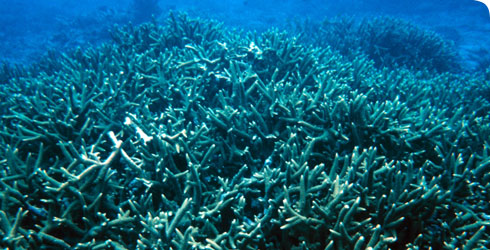Extinction of coral reefs
Coral reefs are fragile ecosystems that are very vulnerable to changes in ocean temperature. Their populations are rapidly declining. Global warming is one of the factors responsible for this.
Coral extinctions in the past
To find out how coral reefs might respond to climate change we can look at what has happened to them in the past.
Museum scientist Ken Johnson studies coral reefs in the Late Cenozoic era, between 30 million years ago and the present day. In this time, there were 2 occasions when many reef-corals became extinct in the Caribbean.
Different types of extinction
Reefs are made up of a number of different species of coral. In the extinction that took place 1 million years ago, coral reefs flourished but the number of species they contained dropped.
In the extinction that took place in the Oligocene period, 24 million years ago, both the overall area of coral reef and the number of species declined.
There are several theories about the cause of these coral extinctions and changes in reef growth. Some of them are based on changes in climatic conditions in the oceans.
Effects of the Central American isthmus on the reefs
Until about 4 million years ago, the Pacific and Atlantic oceans were connected, as the isthmus of Central America did not exist.
Many scientists think that the Oligocene extinction 24 million years ago was caused by increased amounts of water flowing from the Pacific into the Atlantic at that time.
Water from the Eastern Pacific is rich in nutrients that have been brought up to the surface from the deep sea. Coral reefs thrive in water with low nutrients, but they do not usually survive in nutrient-rich waters.
An increased flow of Pacific water in the Caribbean during the Oligocene would have caused the death of corals and coral reefs that were adapted to life in nutrient-poor habitats.
In the 10s of millions of years following this demise, new kinds of corals evolved that were able to live under the changed conditions. However, they were rarely able to build extensive coral reef systems.
The reefs after the isthmus closed
Once the Central American isthmus closed, the nutrient supply was cut off and reefs could once again develop. But this change in environment also caused the extinction of over half of the coral species living in the region.
Modern Caribbean reefs are constructed by relatively few species that evolved prior to the extinction. These species were not able to become dominant until the isthmus closed and new environmental conditions were established.
Coral reefs today
As the Earth warms again, coral reefs are struggling once more. Worldwide, reefs are currently declining more quickly than rainforests are being cut down. As with the Oligocene extinction, once they are gone they will be gone for a long time and, even if they recover, they will surely look very different to living reefs.
Extinctions in the sea
Extinctions of marine organisms are not as well-documented as extinctions of land-living animals. But that does not make them less important.
The oceans are home to 230,000 known kinds of life, but scientists think that as many as 80% of species on the planet may yet be undiscovered, the majority of which live in the ocean. Until we identify more of these species, we will not know how many of them are becoming extinct due to global warming.
Impacts on humans
The extinction of coral reefs would have a knock-on effect on species that depend on them. Fish that live on coral reefs will be threatened and fisheries on the reefs will be damaged.
Thousands of tourists visit coral reefs every year to go diving and snorkelling, and so tourism has become an important part of the local economy in some regions. Without the coral reefs, this part of the economy would collapse.
The loss of both fisheries and tourism could leave people living near coral reefs without a livelihood.
Toolbox

Our scientists study the snails that host the schistosomiasis parasite, which causes a disease that affects nearly 200 million people.
